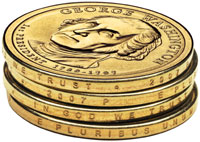Presidential Dollar Edge Lettering

One of the unique features of Presidential Dollars is the edge lettering. The United States Mint refers to this as “edge-incused inscriptions.” The edge lettering has caused some public controversy and produced several unique error coins.
When first released in 2007, the Presidential Dollar Edge Lettering included four things:
- The date
- The mint mark
- The motto “E Pluribus Unum”
- The motto “In God We Trust”
Following the signing of H.R. 2764 “The Consolidation Appropriations Act of 2008,” the motto “In God We Trust” was moved to the obverse of the coin starting in 2009.
The Four Edge Inscriptions
Circulating U.S. coins typically include the date and mint mark on the face of the coin. This makes the placement on the edge somewhat unique. The date indicates the year of mintage, and the mint mark represents where the coin was minted.
Mint marks currently used on Presidential Dollars include “P” representing Philadelphia Mint, “D” representing the Denver Mint, and “S” representing the San Francisco Mint. Philadelphia and Denver strike coins for circulation, and San Francisco strikes Proof coins.
The motto “E Pluribus Unum” first appeared on U.S. coinage in 1795 and became a mandatory inscription in 1873. Translated from Latin, the motto means, “Out of Many, One.” This refers to how many states have combined to form a single nation.
The motto “In God We Trust” has been the official national motto of the United States since 1956. It first appeared on U.S. coinage in 1864, and since 1938, all U.S. coins have included the inscription.
When the Presidential Dollar series began, there was controversy about the supposed omission of the “In God We Trust” motto. Some widely circulated emails and articles mentioned that the motto had been removed from the coins to “phase God out of America.” The same emails and articles often called for a boycott of the new coins. These claims were false, as the motto was included on the edge inscriptions of the coins.
Edge Inscription Errors
Utilizing edge lettering added another layer of difficulty to the minting process of Presidential Dollars. This minting procedure now involved a two-step sequence, each stage demanding precision and attention to detail.

In the first step, blanks are fed into a coining machine, which strikes the obverse and reverse designs on the coins. These coins are then dispensed into a large bin. In the second step, coins from the bins are fed into an edge-incusing machine, which produces the inscriptions.
Because of the process described, the heads-tails orientation of the lettering on circulating coins is random. Approximately one half of the time the lettering will be heads-side up, and one half the time the lettering will be tails-side up.
Errors have occurred when coins have not received the second step of the minting process and were released into circulation without edge lettering. Other errors have occurred when the edge lettering has been doubled or doubled and inverted. Find more information on Presidential Dollar Errors.
Edge Lettering Changes for 2009
On December 26, 2007, the President signed into law H.R. 2764, which has implications for the edge lettering found on Presidential Dollars. The new law requires that the motto “In God We Trust” be moved to the obverse or reverse of the coins “as soon as practicable after the date of enactment.”
The U.S. Mint later released an official statement that they would make this change beginning with 2009 Presidential Dollars, the same year that the new Native American Dollars made their debut.
< “God We Trust” (2009) | Presidential Dollar Errors >

